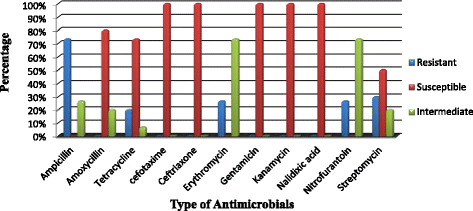Occurrence of Escherichia coli O157:H7 in cattle feces and contamination of carcass and various contact surfaces in abattoir and butcher shops of Hawassa, Ethiopia
- PMID: 28122502
- PMCID: PMC5264334
- DOI: 10.1186/s12866-017-0938-1
Occurrence of Escherichia coli O157:H7 in cattle feces and contamination of carcass and various contact surfaces in abattoir and butcher shops of Hawassa, Ethiopia
Abstract
Background: Despite of the sanitation measures in municipal abattoirs to reduce contamination, Escherichia coli continues to be a health hazard. The present study was conducted on 150 apparently healthy slaughtered cattle at municipal abattoir and in 50 different butcher shops in Hawassa town, Ethiopia. The objectives of the study were investigating the occurrence and antimicrobial resistance of E. coli O157:H7 isolated from fecal samples, carcasses swab, contacts surfaces (swabs of meat handlers hands, knife and clothes of meat transporters) as well as from butcher shops (meat samples, swabs from cutting board swab, butcher men hand and knife surface). E. coli O157:H7 was isolated and identified using bacteriological culture, biochemical tests and Biolog identification system. All E. coli O157:H7 isolates were then checked for their antimicrobial susceptibility pattern using eleven selected antimicrobial discs.
Results: Of the entire set of 630 samples, 2.4% (15/630) (95% CI = 1.3-3.9%) were positive for E. coli O157:H7. When disaggregated by the sources of the samples, E. coli O157:H7 were prevalent in 2.8% (11 of 390) of the abattoir samples, of which 4.7% of the fecal sample and 2.7% of the carcass swabs. And E. coli O157:H7 were positive in 1.7% (4 of 240) of butcher shop specimens of which 2% of meat sample and 3.3% of Cutting board swabs. No statistically significant difference in the prevalence of E. coli 0157: H7 between sex, origin, and breed of cattle. The isolated E. coli O157:H7 were found to be100% susceptible to cefotaxime, ceftriaxone, gentamycin, kanamycin and nalidixic acid.
Conclusion: This study concludes the occurrence of E. coli O157:H7 and the presence of multiple antibiotic resistance profiles in cattle slaughtered at Hawassa municipal abattoir and retail meat sold at butcher shops. This indicates high risk to public health especially in Ethiopia where many people consume raw or under cooked meat. Regulatory control of antibiotics usage in livestock production and pharmaco-epidemiological surveillance in food animals and animal products is hereby recommended to ensure consumer safety.
Keywords: Abattoir; Antimicrobial susceptibility; Biolog system; Butcher shops; E. coli O157:H7.
Figures
Similar articles
-
Prevalence of Escherichia coli O157:H7 in beef cattle at slaughter and beef carcasses at retail shops in Ethiopia.BMC Infect Dis. 2017 Apr 17;17(1):277. doi: 10.1186/s12879-017-2372-2. BMC Infect Dis. 2017. PMID: 28412931 Free PMC article.
-
Prevalence and antimicrobial susceptibility of Escherichia coli O157 in beef at butcher shops and restaurants in central Ethiopia.BMC Microbiol. 2017 Mar 3;17(1):49. doi: 10.1186/s12866-017-0964-z. BMC Microbiol. 2017. PMID: 28253847 Free PMC article.
-
Escherichia coli O157:H7: distribution, molecular characterization, antimicrobial resistance patterns and source of contamination of sheep and goat carcasses at an export abattoir, Mojdo, Ethiopia.BMC Microbiol. 2019 Sep 12;19(1):215. doi: 10.1186/s12866-019-1590-8. BMC Microbiol. 2019. PMID: 31510932 Free PMC article.
-
Escherichia coli O157:H7 in beef cattle: on farm contamination and pre-slaughter control methods.Anim Health Res Rev. 2011 Dec;12(2):197-211. doi: 10.1017/S1466252311000132. Anim Health Res Rev. 2011. PMID: 22152293 Review.
-
Super shedding of Escherichia coli O157:H7 by cattle and the impact on beef carcass contamination.Meat Sci. 2010 Sep;86(1):32-7. doi: 10.1016/j.meatsci.2010.04.019. Meat Sci. 2010. PMID: 20627603 Review.
Cited by
-
vB_EcoM-P896 coliphage isolated from duck sewage can lyse both intestinal pathogenic Escherichia coli and extraintestinal pathogenic E. coli.Int Microbiol. 2025 Jan;28(1):49-60. doi: 10.1007/s10123-024-00519-5. Epub 2024 Apr 13. Int Microbiol. 2025. PMID: 38613721
-
Corrigendum to "Multidrug resistance from a one health perspective in Ethiopia: a systematic review and meta-analysis of literatures (2015-2020)" [One Health 14(2022) 1-12/100390].One Health. 2024 Dec 24;20:100961. doi: 10.1016/j.onehlt.2024.100961. eCollection 2025 Jun. One Health. 2024. PMID: 40630109 Free PMC article.
-
Detection and Isolation of Escherichia coli O157:H7 in Beef from Food Markets and Fecal Samples of Dairy Calves in the Peruvian Central Highlands.Am J Trop Med Hyg. 2023 Jul 24;109(3):568-570. doi: 10.4269/ajtmh.23-0181. Print 2023 Sep 6. Am J Trop Med Hyg. 2023. PMID: 37487566 Free PMC article.
-
First isolation of verocytotoxin-producing Escherichia coli O157:H7 from sports animals in Southern Thailand.Vet World. 2022 Sep;15(9):2275-2284. doi: 10.14202/vetworld.2022.2275-2284. Epub 2022 Sep 23. Vet World. 2022. PMID: 36341074 Free PMC article.
-
Assessment of Food Safety Knowledge, Attitudes, and Practices among Meat Handlers in Bishoftu City, Ethiopia.Am J Trop Med Hyg. 2022 Nov 21;108(1):200-205. doi: 10.4269/ajtmh.22-0268. Print 2023 Jan 11. Am J Trop Med Hyg. 2022. PMID: 36410324 Free PMC article.
References
-
- Raji M, Minga U, Machangu R. Current epidemiological status of enterohaemorrhagic Escherichia coli O157:H7 in Africa. Chin Med J. 2006;119:217–22. - PubMed
-
- Hiko A, Asrat D, Zewde G. Occurrence of Escherichia coli O157:H7 in retail raw meat products in Ethiopia. J Infect Dev Ctries. 2008;2:389–93. - PubMed
MeSH terms
Substances
LinkOut - more resources
Full Text Sources
Other Literature Sources
Medical


